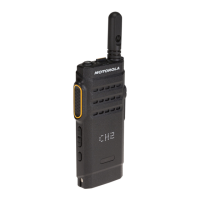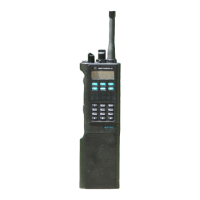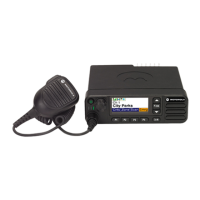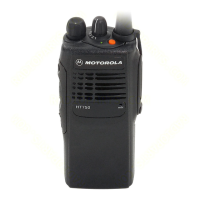The radio operates on the single slot packet data channel.
Packet data applications reside internally, for example: GNSS reports, WAP, or in an external device
connected to the 8–wire RS232 data port on the radio. Communication to the external device is
initialized using AT commands.
The system provides point-to-point IP connectivity allowing the following datagram exchanges:
• Radio ←→ External Equipment (TE) (for example PC).
• External Equipment (TE) ←→ Network (through radio).
The radio supports IP version 4 packet.
TNP1 services can use one of two Point-to-Point Protocol (PPP) methods to connect from the terminal
equipment to the radio, local mode, and wide mode. The TNP1 should be used in wide-mode wherever
possible, to allow the parallel operation of TNP1-SDS services and packet data services over a
common PPP link.
If the transmit inhibit is entered, the radio drops the wide mode connection, thus the PEI goes back to
AT mode. Then the TNP1 client detects this change and reinitiates the PPP session in local mode.
The radio disables the TNP1 session while being in the Direct Mode Operation (DMO).
AT commands are used to initiate the PPP service for TNP1 to operate. Once the PPP session is
running all AT commands are blocked. When the PPP session is closed, AT commands are available.
2.13.1
TETRA Network Protocol 1 IP Addressing
Table 7: TETRA Network Protocol 1 (TNP1) IP Addressing
Addressing
Mode
Description
Wide Mode All TNP1 services are available including packet data transfer towards the SwMI.
The address used is the dynamic address MS IP or configured statically.
Local Mode All TNP1 services are available except packet data transfer. The addresses used
are the two static addresses TE IP: 10.0.0.101 and MT IP: 10.0.0.100.
Port Ad-
dressing
The radio uses a fixed port address for reception and transmission of TNP1 pack-
ets. The port number is 4024.
2.14
Mobility Services
Terminal mobility indicates the ability of a terminal to acquire, register, and operate on an appropriate
TETRA network and also to change cells when the conditions require it with a minimum interruption of
services.
2.14.1
Main Control Channel Frequencies
The radio can find a wide range of main control channels. The radio maintains stored lists of carrier
frequencies which are scanned in order.
1
A list of discrete entries of the last 32 control channels used by the radio.
2
A static list of up to 32 discrete frequencies specified by the operator that can be preprovisioned.
The system operator can modify this list using the programming tool.
MN002955A01-AA
Chapter 2: Services and Features
Send Feedback 39
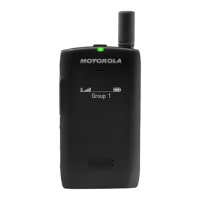
